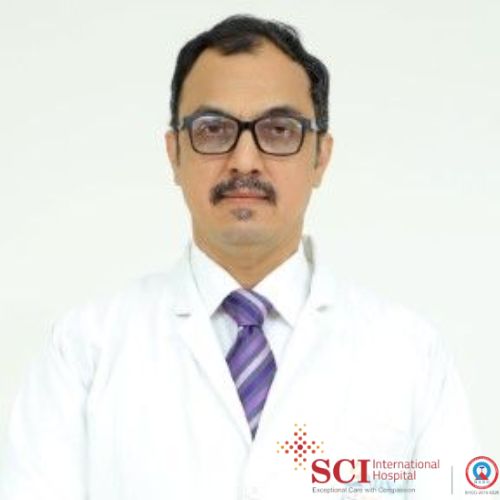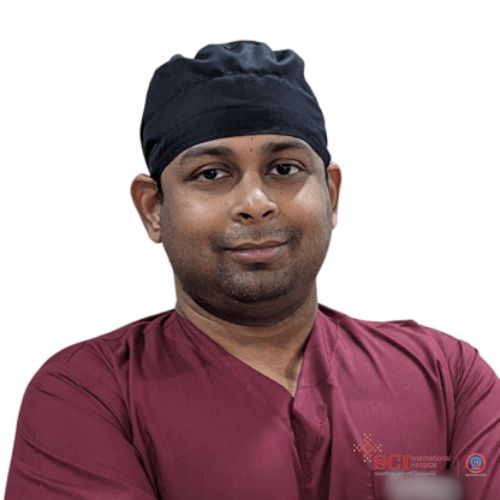Picture yourself playing your favorite sport or just going about your regular day when suddenly – ouch! You feel a sharp pain, notice swelling, and hear an alarming "pop" sound. This uncomfortable experience often means you've injured a ligament, which is quite common but can significantly affect your mobility. The good news? If you're in Delhi, SCI Hospital has skilled doctors who know exactly how to help you get better and feel strong again. Let's explore what these important body parts do and how we can fix them when they get damaged.
We Are Rated
Consult Now
Your body has amazing helpers called ligaments that work hard every day to keep you moving safely. These are strong yet flexible strips of tissue composed primarily of tough proteins, including collagen and elastin, which is a stretchy protein.
These helpful tissues also stop your joints from bending too far or moving in dangerous directions. Plus, they help your body understand where it is in space – that's called proprioception. This amazing ability helps you stay balanced and coordinated when you walk, run, or dance.
A ligament injury happens when these strong bands get stretched too much or tear because of too much force or weird movements.
Here are some common ways people hurt their ligaments:
Sometimes, even careful, fit people can get these injuries. It shows us that our bodies, while amazing, can be more fragile than we think.
Doctors group ligament injuries into three main types based on how bad they are. This helps them decide the best way to treat you:
Your knee gets hurt more often than other joints because it's complicated and deals with a lot of stress every day.
Ankle sprains are some of the most common ligament injuries. They usually happen when you "roll" your ankle inward too far. These can be mild stretches or complete tears, and if you don't treat them properly, your ankle might stay weak and unstable for a long time.
Your shoulder joint isn't very stable naturally, which makes it more likely to get ligament injuries, especially when it gets dislocated. While shoulder problems often involve tendons, rotator cuff tears are also common and really affect how stable your shoulder feels.

MBBS, Diploma in Anesthesiology, MS - Orthopaedics, Orthopaedic surgeon, Joint Replacement Surgeon

MBBS, MS - Orthopaedics, Orthopaedic surgeon
Wrist ligament injuries often happen when you try to catch yourself with your hands during a fall. One well-known example is "gamekeeper's thumb," which tears the ligament at the base of your thumb. This often happens when you fall while holding something like ski poles.
Knowing the signs of a ligament tear helps you get treatment quickly, which leads to better healing. Here are the main things to watch for:
You should see an orthopedic specialist at SCI Hospital right away if you have:
At SCI Hospital, the specialists use several methods to figure out exactly what's wrong and how bad your injury is:
At SCI Hospital, every treatment plan is designed specifically for you and your injury. The approach depends on how bad your tear is, what kind of lifestyle you have, and what your recovery goals are. The hospital brings together bone doctors, surgeons, sports medicine doctors, radiologists, and physical therapists to make sure you get complete, coordinated care.
R.I.C.E. Protocol: Rest, Ice, Compression, and Elevation
This is the basic first treatment for most sprains and strains, and it's really important in the first 24 to 72 hours:
For moderate tears (Grade 2) or to help Grade 1 injuries heal properly, your doctor might suggest a brace, splint, or cast. These devices support your injured joint, take pressure off the healing ligament, help keep everything aligned properly, and prevent more damage while you're healing.
Physical therapy is a really important part of non-surgical treatment and usually starts once your initial pain and swelling get better. A licensed physical therapist at SCI Hospital will create a special exercise program just for you to:
Over-the-counter medicines like ibuprofen or naproxen can help relieve pain and reduce swelling. For worse pain or inflammation, your doctor might prescribe stronger medicines, including corticosteroids.
Besides the immediate R.I.C.E. treatment, home remedies mainly involve carefully following rest, ice, compression, elevation, and taking over-the-counter pain relievers as directed.
It's important to avoid activities that cause pain and slowly start moving again as the pain allows.
A sprain happens when a ligament gets stretched or torn, while a tear refers to a more severe injury where the ligament fibers are significantly or completely broken. For expert advice and treatment, consider consulting SCI Hospital for a proper diagnosis and personalized care plan. You can book an appointment through a phone call or online consultation.
Recovery time varies, but with SCI Hospital, you can expect a comprehensive rehabilitation plan tailored to your needs. For a complete ACL tear, recovery typically takes 6 to 9 months. Book an appointment with SCI Hospital to discuss your specific situation and create a personalized recovery plan. You can reach them through a phone call or an online consultation.
Yes, many ligament tears can heal without surgery. SCI Hospital offers non-surgical treatments, including the R.I.C.E. protocol, immobilization, and physical therapy. For a consultation, book an appointment with SCI Hospital through a phone call or online, and their experts will guide you on the best course of treatment.
While generally safe, ligament tear surgery does carry some risks. SCI Hospital has experienced surgeons and a dedicated team to minimize these risks. To discuss your concerns and options, book an appointment with SCI Hospital through a phone call or online consultation, and they will provide you with personalized advice and care.
To reduce your risk of ligament injuries, warm up before physical activity, strengthen your lower body and core muscles, and improve your balance and coordination skills. For expert guidance on preventing ligament injuries, consult SCI Hospital. Book an appointment through a phone call or online consultation, and their team will provide you with personalized tips and advice.
Consult Now
